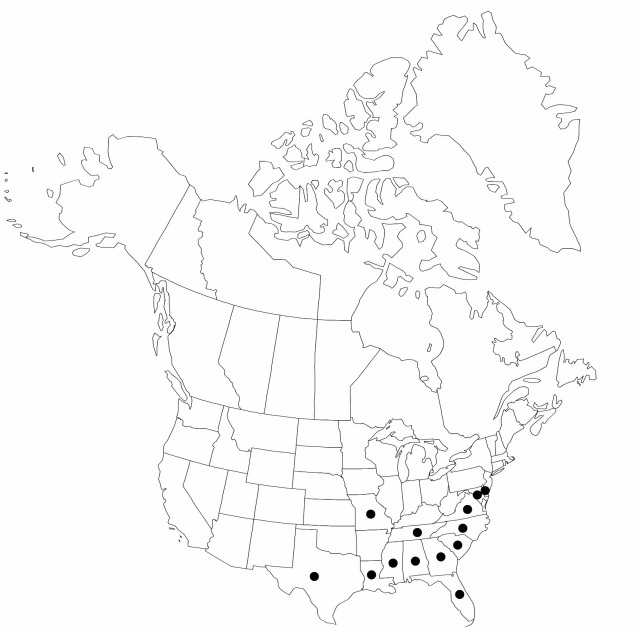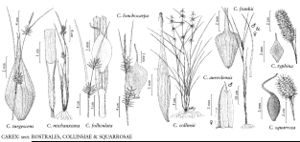Difference between revisions of "Carex lonchocarpa"
Syst. Veg. 3: 817. 1826.
FNA>Volume Importer |
imported>Volume Importer |
||
| (6 intermediate revisions by 2 users not shown) | |||
| Line 6: | Line 6: | ||
|place=3: 817. 1826 | |place=3: 817. 1826 | ||
|year=1826 | |year=1826 | ||
| + | }} | ||
| + | |special_status={{Treatment/ID/Special_status | ||
| + | |code=F | ||
| + | |label=Illustrated | ||
| + | }}{{Treatment/ID/Special_status | ||
| + | |code=E | ||
| + | |label=Endemic | ||
}} | }} | ||
|basionyms= | |basionyms= | ||
| Line 11: | Line 18: | ||
|name=Carex folliculata var. australis | |name=Carex folliculata var. australis | ||
|authority=L. H. Bailey | |authority=L. H. Bailey | ||
| − | }}{{Treatment/ID/Synonym | + | |rank=variety |
| + | }} {{Treatment/ID/Synonym | ||
|name=Carex smalliana | |name=Carex smalliana | ||
|authority=Mackenzie | |authority=Mackenzie | ||
| + | |rank=species | ||
}} | }} | ||
|hierarchy=Cyperaceae;Carex;Carex sect. Rostrales;Carex lonchocarpa | |hierarchy=Cyperaceae;Carex;Carex sect. Rostrales;Carex lonchocarpa | ||
| Line 29: | Line 38: | ||
|elevation=0–600 m | |elevation=0–600 m | ||
|distribution=Ala.;Del.;Fla.;Ga.;La.;Md.;Miss.;N.C.;S.C.;Tenn.;Tex.;Va. | |distribution=Ala.;Del.;Fla.;Ga.;La.;Md.;Miss.;N.C.;S.C.;Tenn.;Tex.;Va. | ||
| − | |discussion=<p>Carex lonchocarpa, often regarded as a variety of C. folliculata, is smaller than C. folliculata and usually has narrower leaves, fewer lateral spikes (these usually with a staminate apex and erect or spreading), shorter but relatively broader achenes, shorter pistillate scales, and narrower perigynia that are somewhat reflexed at maturity. Substantial differences in achene micromorphology also support recognition of C. lonchocarpa as a distinct species (D. E. Wujek and F. J. Menapace 1986). The ranges of these two taxa are largely allopatric, although they overlap slightly in southern Virginia, eastern Maryland, and Delaware.</p> | + | |discussion=<p><i>Carex lonchocarpa</i>, often regarded as a variety of <i>C. folliculata</i>, is smaller than <i>C. folliculata</i> and usually has narrower leaves, fewer lateral spikes (these usually with a staminate apex and erect or spreading), shorter but relatively broader achenes, shorter pistillate scales, and narrower perigynia that are somewhat reflexed at maturity. Substantial differences in achene micromorphology also support recognition of <i>C. lonchocarpa</i> as a distinct species (D. E. Wujek and F. J. Menapace 1986). The ranges of these two taxa are largely allopatric, although they overlap slightly in southern Virginia, eastern Maryland, and Delaware.</p> |
|tables= | |tables= | ||
|references= | |references= | ||
| Line 38: | Line 47: | ||
-->{{#Taxon: | -->{{#Taxon: | ||
name=Carex lonchocarpa | name=Carex lonchocarpa | ||
| − | |||
|authority=Willdenow ex Sprengel | |authority=Willdenow ex Sprengel | ||
|rank=species | |rank=species | ||
| Line 52: | Line 60: | ||
|publication title=Syst. Veg. | |publication title=Syst. Veg. | ||
|publication year=1826 | |publication year=1826 | ||
| − | |special status= | + | |special status=Illustrated;Endemic |
| − | |source xml=https:// | + | |source xml=https://bitbucket.org/aafc-mbb/fna-data-curation/src/2e0870ddd59836b60bcf96646a41e87ea5a5943a/coarse_grained_fna_xml/V23/V23_964.xml |
|genus=Carex | |genus=Carex | ||
|section=Carex sect. Rostrales | |section=Carex sect. Rostrales | ||
Latest revision as of 20:44, 5 November 2020
Culms obtusely trigonous in cross section, (25–)35–125 cm, smooth. Leaves: ligules 1.5–13(–18) mm, narrower to wider than long; blades yellowish or light green, M-shaped to flat, widest leaves of vegetative shoots (3.5–)4–12 mm wide, smooth or sometimes papillose adaxially, especially distally. Inflorescences (3–)15–50 cm; bract sheaths prolonged, apex truncate to convex; proximal (1–)2–4 spikes usually androgynous or, occasionally, pistillate, erect or the proximal spreading, ovoid to short cylindric. Pistillate scales ovate to narrowly ovate, mostly 1/2–2/3 as long as perigynia, apex acute to acuminate-awned. Anthers 3–5 mm. Perigynia spreading to somewhat reflexed, pale green, 20–26-veined, essentially uninflated, lanceolate, (8.3–) 10.5–13.5(–15) × 1.5–2.4 mm, 4–7 times as long as wide, apex tapered to bidentulate; beak absent. Achenes 2.3–3.4(–3.8) × 1.8–2.4 mm, 1.3–1.8 times as long as wide.
Phenology: Fruiting late spring–summer.
Habitat: Wet savannas, forests, seeps, stream banks, lakeshores, in sandy, peaty, or acidic soils
Elevation: 0–600 m
Distribution

Ala., Del., Fla., Ga., La., Md., Miss., N.C., S.C., Tenn., Tex., Va.
Discussion
Carex lonchocarpa, often regarded as a variety of C. folliculata, is smaller than C. folliculata and usually has narrower leaves, fewer lateral spikes (these usually with a staminate apex and erect or spreading), shorter but relatively broader achenes, shorter pistillate scales, and narrower perigynia that are somewhat reflexed at maturity. Substantial differences in achene micromorphology also support recognition of C. lonchocarpa as a distinct species (D. E. Wujek and F. J. Menapace 1986). The ranges of these two taxa are largely allopatric, although they overlap slightly in southern Virginia, eastern Maryland, and Delaware.
Selected References
None.
